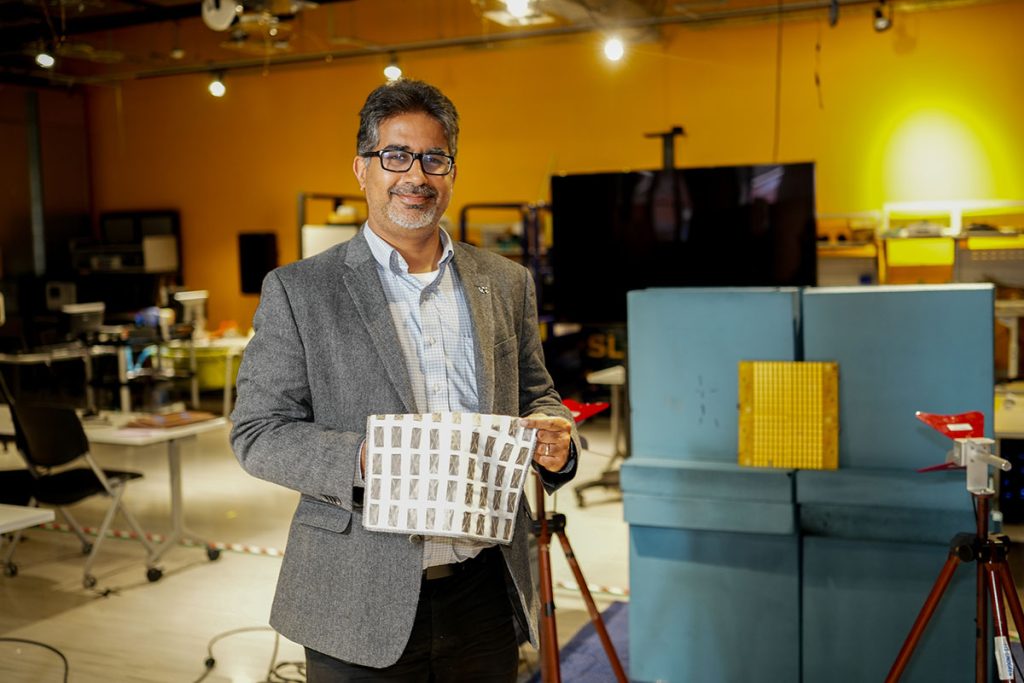Flexible, fabric surface can shape radio and wireless signals, accelerate IoT research.
The Internet of Things (IoT) has experienced explosive growth over the past decade, with the market research company IoT Analytics predicting there will be over 30 billion connected devices worldwide by 2025. Coupled with sixth-generation (6G) wireless communication networks expected to be deployed in the 2030s, this proliferation of smart, interconnected devices is creating both opportunities and challenges, requiring continued innovation to fully realize the promise of an intelligent, responsive network of objects.
Kapil Dandekar, PhD, E. Warren Colehower Chair Professor in electrical and computer engineering, is on the forefront of this effort. Among the most exciting projects in Dandekar’s wide-ranging research in 6G and IoT is his work with reconfigurable intelligent surfaces, which allows him and other researchers to quickly test new interactions between devices. His work promises to accelerate the development of robust and secure 6G and IoT systems that can enable smarter homes, cities and industries.

offer advantages over traditional, circuit board-
based types.
Reconfigurable intelligent surfaces (RIS) are made up of controllable elements that can manipulate wireless signals as they propagate from a transmitter to a receiver. By controlling these elements with machine learning, an RIS can “shape” the wireless signals that reach your phone or computer. This allows RIS to do things like boost signals in dead zones or block hackers from accessing your devices.
“RIS technology provides an unprecedented ability to control how radio waves propagate in an environment,” explained Dandekar. “This opens many new possibilities for wireless communications and sensing. You can have wireless devices that can more robustly and securely communicate with one another while co-existing in networks that have many more devices than what we have available today.”
But Dandekar and his team are pushing the boundaries of the technology with the creation of a flexible, fabric-based RIS. Traditional RIS prototypes have been made using rigid printed circuit boards, limiting where they can be deployed. Dandekar’s breakthrough fabric RIS prototype opens up new possibilities for integrating RIS into everyday environments and objects, such as carpets, drapes and upholstery.

The RIS prototype was designed and fabricated in conjunction with Drexel’s Center for Functional Fabrics using a combination of conductive and non-conductive textiles. Each conductive element acts as a tunable radio frequency switch with two states — ON and OFF. In the ON state, the elements connect to form reflective antennas that steer signals. In the OFF state, the elements are isolated to allow the transmission of signals through the surface. By testing wireless power transmission with the switches ON versus OFF, the researchers demonstrated a significant reduction in power, validating that the fabric surface could perform at a level comparable to an RIS built on a printed circuit board.
“By integrating everyday fabrics into RIS technology, we open up an enormous range of possibilities to unobtrusively deploy adaptive wireless surfaces throughout our environments and objects,” Dandekar noted. “For example, RIS wallpapers could shape indoor signals to enable dense wireless networks, and smart garments lined with RIS fabrics could boost device connectivity or integrate with medical wearables to monitor vital signs and remotely trigger treatment devices like respirators. We’ve only begun scratching the surface of applications.”
In collaboration with Drexel Applied Innovation, Dandekar is reaching out to potential industry partners to get feedback and seek collaboration on his RIS innovations. While much of his research focuses on using the technology to improve IoT, 6G and other consumer wireless communications protocols, there are also applications in a novel area: electronic warfare and cybersecurity.
Dandekar’s team showed RIS could provide a new defensive approach against directed energy weapons (DEW), which focus high-power radio frequency attacks on critical electronics and infrastructure. Drexel’s mitigation strategies leverage passive antennas with electronically tunable phase and amplitude.

integrated into exposed wall art or
hidden in rugs, curtains or furniture.
“Our testing has shown that the integration of wideband circularly-polarized antenna systems with RIS technology can be used to alleviate DEW attacks across a wide range of frequencies, regardless of the polarization of electromagnetic waves.” Dandekar explained.
A key advantage of RIS is its scalable nature. A surface can cover small product enclosures or be scaled up to protect entire buildings and complexes, providing a novel, flexible defense, unlike current, more rigid alternatives.
“The full potential of RIS is still being uncovered,” Dandekar says. “I hope our fundamental research on expanding the wireless engineering toolkit will lead to RIS technologies that provide meaningful benefits to society in the coming years.”
Dandekar’s pioneering research has led to numerous publications, patents and partnerships with industry. He plans to continue pushing the boundaries of what’s possible, training creative students and working with companies to bring these powerful new wireless technologies to life.


